Main menu
Common skin conditions

NEWS
Join DermNet PRO
Read more
Quick links
Bazex-Dupré-Christol syndrome — extra information
Bazex-Dupré-Christol syndrome
Author: Vanessa Ngan, Staff Writer, 2005. DermNet Update October 2021
Introduction Demographics Causes Clinical features Complications Differential diagnoses Diagnosis Treatment Outcome
What is Bazex-Dupré-Christol syndrome?
Bazex-Dupré-Christol syndrome is a rare genodermatosis characterised by the triad of congenital hypotrichosis and follicular atrophoderma, with subsequent development of multiple basal cell carcinomas. It is categorised as an 'ectodermal dysplasia with an hereditary tumour' syndrome.
It is sometimes called 'follicular atrophoderma-basal cell carcinoma' and 'Bazex syndrome'; the latter is best avoided as acrokeratosis neoplastica is also known as 'Bazex syndrome', an unrelated rare paraneoplastic syndrome.
Bazex-Dupré-Christol syndrome: classic triad of clinical features
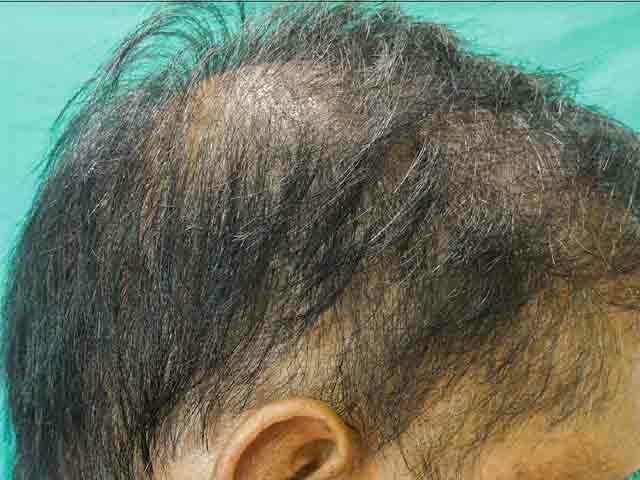
Bazex‑Dupré‑Christol syndrome: hypotrichia
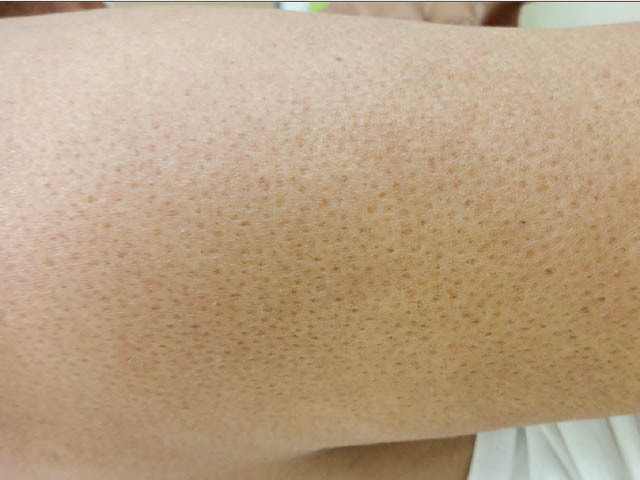
Bazex‑Dupré‑Christol syndrome: follicular atrophoderma
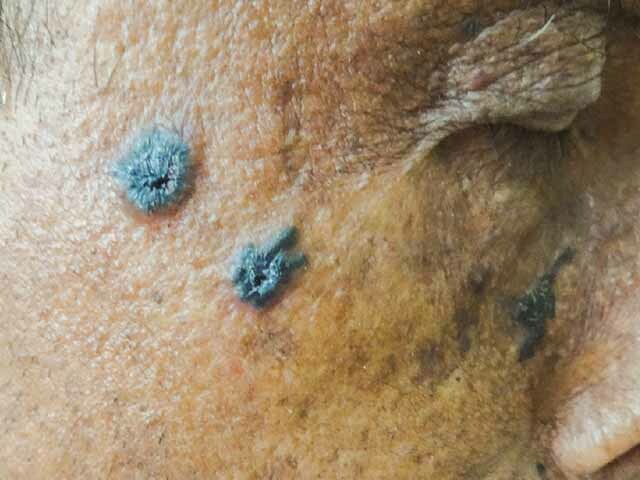
Bazex‑Dupré‑Christol syndrome: pigmented basal cell carcinomas
Images from: Chauhan P, Meena D, Dhanta A, Kansal NK, Durgapal P. Bazex-Dupré-Christol syndrome: first report in an Indian family. Indian J Dermatol Venereol Leprol. 2018;84(4):451–6.
Who gets Bazex-Dupré-Christol syndrome?
Bazex-Dupré-Christol syndrome is rare, reported in approximately 20 families worldwide. Males and females are equally affected, but male-to-male inheritance does not occur. Sporadic cases have been described.
What causes Bazex-Dupré-Christol syndrome?
Bazex-Dupré-Christol syndrome is an X-linked dominant inherited disorder. This means 50% of children of an affected female, and all daughters of an affected male will inherit the syndrome.
Bazex-Dupré-Christol syndrome results from a mutation in the ACTRT1 gene causing depletion of the tumour suppressor ARP-T1, a non-coding mRNA. ARP-T1 is required for the assembly of cilia, microtubule organelles.
What are the clinical features of Bazex-Dupré-Christol syndrome?
Bazex-Dupré-Christol syndrome typically shows some clinical features at birth, although these may not always be recognised at that time. Males tend to always have severe disease whereas females can show a range of severity.
Follicular atrophoderma
- Present at birth
- Ice pick scars
- Backs of hands, elbows, feet, and face
- Require careful examination to see
Hair abnormalities
- Present at birth
- Hypotrichosis - reduced body and scalp hair
- May be mild or absent in females
- Hair shaft abnormalities including pili torti may be also found
Basal cell carcinomas
- Onset in early adult life
- Develop on the face
- Multiple
Other cutaneous features sometimes present
-
Milia 65%
- Face and limbs
- Multiple
- Hypohidrosis or anhidrosis 54%
- May be localised or generalised
- Dry skin
- Trichoepithelioma
- Epidermoid cyst
- Characteristic facies
- Hyperpigmentation
Cutaneous signs of Bazex-Dupré-Christol syndrome
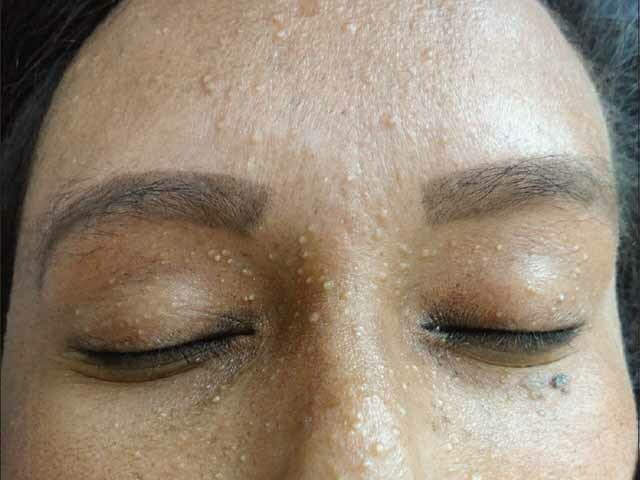
Bazex‑Dupré‑Christol syndrome: facial milia
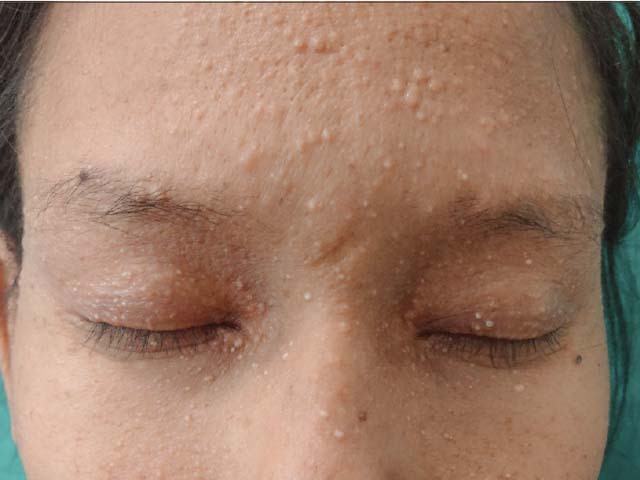
Bazex‑Dupré‑Christol syndrome: facial milia
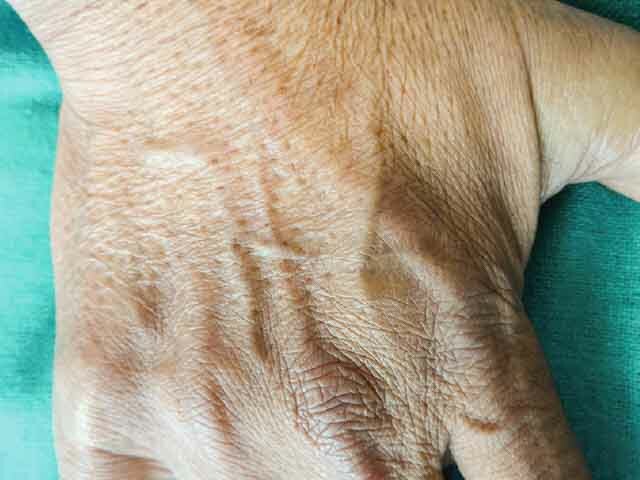
Bazex‑Dupré‑Christol syndrome: follicular atrophoderma
Images from: Chauhan P, Meena D, Dhanta A, Kansal NK, Durgapal P. Bazex-Dupré-Christol syndrome: first report in an Indian family. Indian J Dermatol Venereol Leprol. 2018;84(4):451–6.
What are the complications of Bazex-Dupré-Christol syndrome?
- Psychosocial impact of having multiple skin cancers and their treatment.
What is the differential diagnosis of Bazex-Dupré-Christol?
- Rombo syndrome - is clinically similar but has autosomal dominant inheritance
- Other ectodermal dysplasias
- Basal cell naevus syndrome
- Atrophoderma vermiculatum (variant of keratosis pilaris atrophicans faciei)
How is the diagnosis of Bazex-Dupré-Christol made?
Bazex-Dupré-Christol syndrome is a clinical diagnosis and should be considered in patients with early-onset or familial basal cell carcinomas. Follicular atrophoderma should be looked for carefully as this is an early sign easily missed.
What is the treatment for Bazex-Dupré-Christol syndrome?
General measures
- Sun protection from an early age
- Self skin examination
- Regular skin examinations with a dermatologist
Specific measures
- No cure for Bazex-Dupré-Christol syndrome
- Genetic counselling
- Basal cell carcinomas
- Cryotherapy, photodynamic therapy, fluorouracil cream and imiquimod cream
- Surgery
- Avoid radiotherapy due to the risk of provoking more skin tumours
What is the outcome for Bazex-Dupré-Christol syndrome?
Basal cell carcinomas continue to develop lifelong. There is no association with internal malignancies.
Bibliography
- AlSabbagh MM, Baqi MA. Bazex-Dupré-Christol syndrome: review of clinical and molecular aspects. Int J Dermatol. 2018;57(9):1102–6. doi:10.1111/ijd.14065. PubMed
- Castori M, Castiglia D, Passarelli F, Paradisi M. Bazex-Dupré-Christol syndrome: an ectodermal dysplasia with skin appendage neoplasms. Eur J Med Genet. 2009;52(4):250–5. doi:10.1016/j.ejmg.2008.12.003. PubMed
- Chauhan P, Meena D, Dhanta A, Kansal NK, Durgapal P. Bazex-Dupré-Christol syndrome: first report in an Indian family. Indian J Dermatol Venereol Leprol. 2018;84(4):451–6. doi:10.4103/ijdvl.IJDVL_599_17. Journal
- Glaessl A, Hohenlautner U, Landthaler M, Vogt T. Sporadic Bazex-Dupré-Christol-like syndrome: early onset basal cell carcinoma, hypohidrosis, hypotrichosis, and prominent milia. Dermatol Surg. 2000;26(2):152–4. doi:10.1046/j.1524-4725.2000.99146.x. PubMed
- Park HS, Papanastasi E, Blanchard G, et al. ARP-T1-associated Bazex-Dupré-Christol syndrome is an inherited basal cell cancer with ciliary defects characteristic of ciliopathies. Commun Biol. 2021;4(1):544. doi:10.1038/s42003-021-02054-9. Journal
On DermNet
- Basal cell carcinoma
- Acrokeratosis neoplastica — the other Bazex syndrome
Other websites
